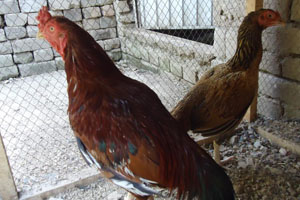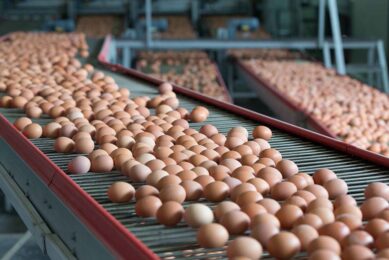Backyard farms with native breeds still important in Indian egg supply

Backyard farmers are still the most important providers of food in India. An important part of the poultry meat and eggs consumed in the country comes from these small scale producers. In the production process they make use of a variety of native breeds.
Indian native breeds are well known for their tropical adaptability and disease resistance, while their colour plumage helps in protecting themselves against predators. The first priority of today’s rural poultry farmer is not only having birds which lay just more eggs but also birds which early lay eggs with an optimum size as well as birds which grow to an optimum body weight and show a good feed efficiency. Producers hereby have a choice out of a number of native breeds.
The Aseel has a short and broad breast, straight back and a close setting strong tail root. Its outstanding feature is its thick and long neck, long and slender face without feathers, short beak, short and small comb, ear lobes and the absence of wattles. Its legs are long, strong and straight and the bird has an upright and majestic gait. It has been traditionally bred for its meat with the average weight of a two year old adult male ranging between 3-4 kg and the average weight of a hen is 2-3kg. With 36-60 eggs laid per year; the Aseel is not a prolific layer. The hen matures and begins to lay eggs between 5-6 months of age, and lays 3-4 clutches per year, with each clutch having 10-12 eggs. Women are primarily interested in producing live birds, and not eggs. Studies have indicated, 95-100% of the total annual eggs laid by a bird are kept to hatch. Of the live birds that hatch and survive, between 60-70% are sold, 15-20% are consumed at home and the remaining 10-15% are kept as breeding stock to increase the flock.
The Kadaknath is an Indian breed of chicken, which is local to the Madhya Pradesh area. Here it is known as “Kali masi” (“fowl having black flesh”). The Kadaknath is popular mainly for its adaptability, and the well-tasting black meat, which is believed to infuse vigour. Kadaknath is the only Black Meat chicken (BMC) breed in India. It is a native bird reared mainly by the tribal communities of Bhil and Bhilala in the Jhabua and Dhar districts of Western Madhya Pradesh. Its colour stems from the deposition of melanin pigment.
The commonly available varieties of Kadaknath are jet-black, pencilled and golden. The bird is very popular mainly due to its adaptability to the local environment, disease resistance, meat quality, texture and flavour. The Kadaknath eggs are light brown. The day-old chicks are brownish to black with irregular dark stripes over the back. The adult plumage varies from silver and gold spangled to bluish black without any spangling.
The skin, beak, shanks, toes and soles of feet are slate-like. The comb, wattles and tongue are purple. Most of the internal organs also show intense black colouration which is also seen in skeleton muscle, tendons, nerves and blood. The meat is repulsive to look at but delicious. The weight of cocks is about 1.5 kg and that of hens is 1.0 kg. The hens are medium layers and they are not good broodies. The CPDO (NR) Chandigarh created awareness for the Kadaknath in the north, where many small farmers have been supplied Kadaknath to take up rural poultry.
The Naked Neck is a breed of chicken that is naturally devoid of feathers on its neck and vent. Naked Neck is a dual-purpose utility chicken. They are very good foragers and are immune to most diseases. Naked Neck roosters carry a single comb, and the neck and head often become very bright red from increased sun exposure.
Frizzle fowl is described as a heavy breed, having a single comb, is clean legged, and has the size of the Plymouth Rock. They come in large fowl and bantams; in addition, frizzle can also be a version of any recognised breed, such as frizzled Japanese, frizzled Cochin. They are kept mostly for their ornamental value.
Krishna J fowl was a replica of indigenous fowl adopted into the family poultry keeping scavenger system for high egg productivity and acceptability as meat fowl. Krishna J is basically a carried sex-linked dwarf gene and has been subjected twice to crossing with coloured broiler to improve its body size than crossed with the light coloured breeds of high egg productivity to sustain egg production.
These indigenous poultry birds are well adapted to harsh Indian environment of free range and they produce egg and meat at the least possible cost. The birds require no scientific feeding, health care, housing and management and thus make the indigenous birds suitable for backyard poultry farming. The raising of synthetic hybrid replicas of indigenous chicken ensures more monetary return than the traditional Desi fowl.
Indian terminology. Jungli Murgi – Jungli murgi (Gallus Gallus) Red Jungle fowl is progenitor of the domestic chicken. Jungle fowl commonly known as Jungli Murgha is facing threat of extinction. Broiler – The term broiler goes back to the turn of century and literally means a young chicken that can be boiled, fried, baked or roasted. Kuroiler – (Kegg+Broiler) Chicken which is custom bred chicken for small farmers. A female kuroiler gives 200 eggs in 18th month cycle; a male kuroiler reaches 1kg weight in 6-7 weeks. Kuroiler adult male weights maximum 2-2.5 kgs. They survive on scavenging, foraging and remainings from kitchens. Kegg refers to Kegg farms Gurgaon. Croiler – It is a mediocre broiler breed cross between broiler and layer as higher demand and higher market return. Desi chicken – Desi chicken is good brooder for ages and efficient mothers. They are known for adaptability to local climate and geographical condition. Desi chickens with hold on their own in low or no input conditions. They vary greatly in their plumage pattern, comb type and body confirmation. |
Join 31,000+ subscribers
Subscribe to our newsletter to stay updated about all the need-to-know content in the poultry sector, three times a week. Beheer
Beheer








 WP Admin
WP Admin  Bewerk bericht
Bewerk bericht